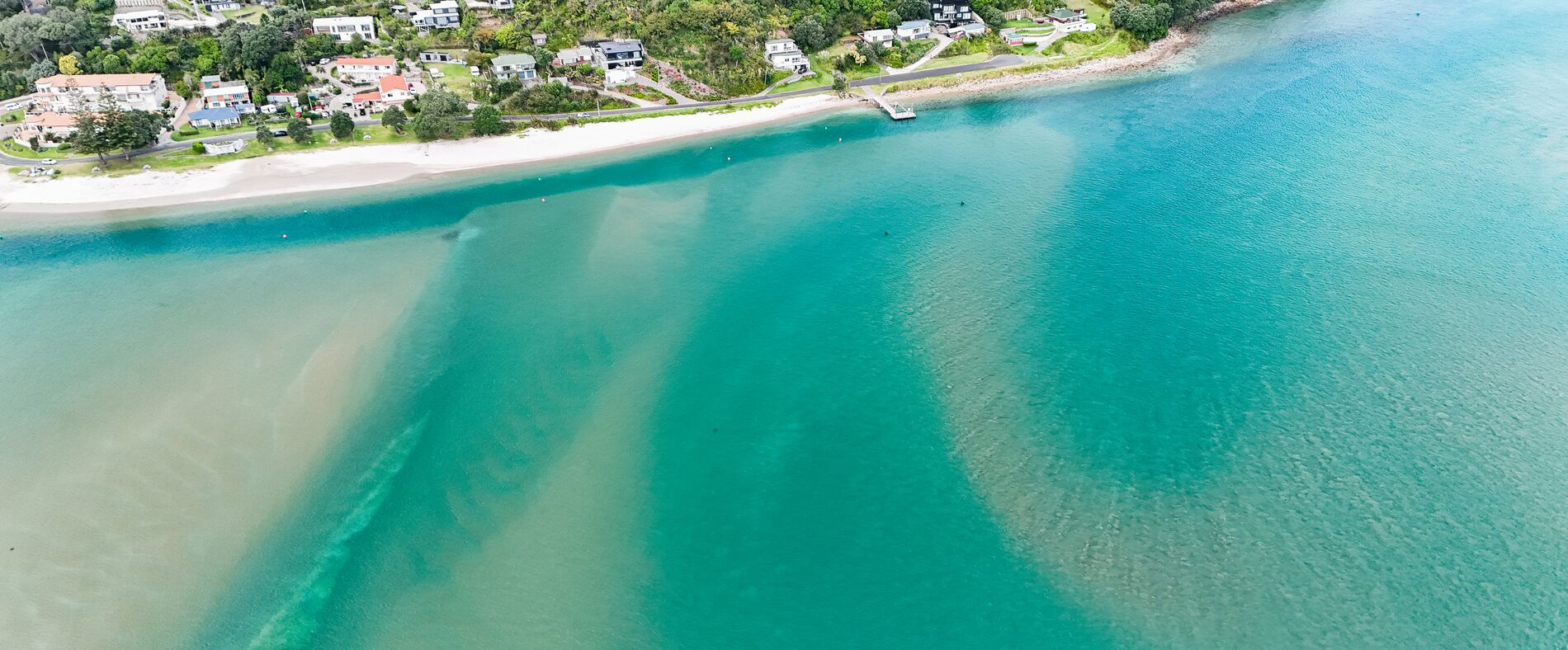The Tairua Harbour, between the beach towns of Tairua and Pāuanui, experiences significant sand movement throughout the year. Weather, currents and dredging work within the harbour are just some of the variables which can affect the build-up of sand. While these movements typically don’t present a problem, at times it can form a sandbar near the mouth of the harbour, causing a large shallow area at lower tidal levels.
This sandbar, or the shallow area that can form, is an ongoing concern for local residents and those who frequent the harbour. It also presents a navigational challenge to those unfamiliar with the harbour and who choose to navigate at low tide. Thames-Coromandel District Council, Waikato Regional Council and Coastguard Tairua-Pauanui have received much communication around the topic over recent years, particularly after large weather events.
Organisational responsibilities
We are certainly sympathetic with some of the concerns raised by the shifting sands, however, it is important to understand that each organisation has a different role in caring for the harbour. While all the organisations work collaboratively, we each have unique but clear responsibilities. As such, we can only carry out work within these responsibilities as this is what we are budgeted and mandated for. Please see below for a detailed overview of each.
Who does what?
Dredging
Our agencies are regularly approached by the public around dredging the harbour.
Neither Waikato Regional Council or Coastguard Tairua-Pauanui hold any consent to dredge the Tairua Harbour or any other harbours within New Zealand, nor is it currently within the responsibilities of either organisation to maintain a clear channel through any given harbour.
Thames-Coromandel District Council does carry out some maintenance dredging within the Tairua Harbour. This is solely to provide safe access to and from their assets. It also allows access for the Coastguard vessel across all tidal ranges. Although TCDC does not dredge to maintain a navigable channel through the harbour, they are looking to develop internal guidelines to define under what circumstances TCDC would consider activating its dredging consent in the future. This would likely be completed as part of finalising the Harbour and Marine Strategy, however this would be budget limited.
All other dredging work in the harbour is carried out privately. Tairua Marina regularly carry dredging to maintain access to their facility, in accordance with their resource consent.
Tairua Harbour is identified as a Significant Indigenous Biodiversity Area – B (SIBA-B). Any dredging operation within the harbour will require resource consent and we recommend any group interested in pursuing dredging to seek professional advice.
Navigation aids
Waikato Harbourmaster maintains the aids to navigation within the Tairua Harbour.
This is done with navigation buoys and may include channel marks.
In recent times, the sands have shifted resulting in the loss of a clear channel. As a result, the Harbourmaster removed navigation marks from the usual channel as there was no longer a channel to mark. The Harbourmaster regularly monitors the harbour to identify the channel movements and provide appropriate navigation aids.
Waikato Regional Council strives to keep the public aware of major changes to the Tairua Harbour via social media, our website and local community channels such as CFM radio and Coastguard Tairua-Pauanui’s social media channels.
Navigation marks are placed according to the best possible passage with the most recent knowledge we can gather. Despite these efforts, sands in Tairua Harbour are extremely prone to shifting, especially during severe weather events. Channels are marked to the best of our ability, however, they may not always reflect the channel perfectly. As is stated on the boat ramp signage and reiterated by us wherever possible: We always recommend that skippers navigating the Tairua/Pāuanui harbour, do so with extreme caution.
Joint recommendations
Anyone planning to cross the Tairua bar is strongly advised to do so near high tide.
This is a position that is unanimously agreed upon by all our organisations.
Crossing at or near low tide is extremely risky. Not only is the chance of grounding in the harbour significantly increased at low tide, but the bar crossing itself is at its most dangerous with the risk of capsize at its highest. Many boaties have died crossing this bar at the wrong time.
As recommended by Coastguard NZ, the safest window of time to cross the bar is three hours before and up to 1.5 hours after high tide.
Vessels with a shallow draft such as runabouts or jetskis can usually navigate much of the harbour even near low tide if exercising caution and travelling slow enough to watch for shallow sections. However, launches and other deep-draught vessels should only ever navigate the harbour near high tide.
As with other tidal, very shallow harbours and estuaries, it comes down to the responsibility of the skipper to navigate at a sensible time and with consideration towards the hazardous nature of such an ever-changing environment. Travelling at/near high tide eliminates almost all major concerns around the sandbar and is the joint recommendation of all three organisations for safe transit through this harbour.
If your vessel does ground and is unable to free itself, the incident should be made known to the Harbourmaster as soon as possible on 0800 800 401. A Maritime Officer is on-call 24/7 on this number. This is especially important if vessel damage presents a risk of environmental pollution via oil or fuel spillage, as containment may be necessary.
Coastguard should also be contacted in the event of a grounding, particularly if there is a risk to life. Coastguard membership is strongly encouraged. Assistance is free if you are a member. Coastguard Tairua-Pauanui can be contacted on VHF channel 04, or in an emergency on channel 16. By phone, you can dial *500 for non-life-threatening situations or 111 for emergencies (request Fire).

